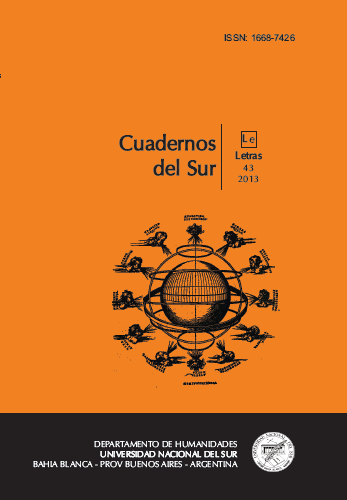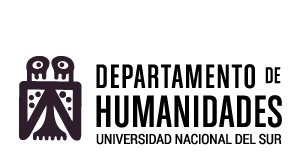La Tempestad, otros “romances” de Shakespeare y la novela griega tardía
Keywords:
Shakespeare, The Tempest Late Greek romance, Post-colonialismAbstract
Interpretations of The Tempest from a postcolonial point of view have prevailed for the last three decades. Some exponents of these interpretations, such as Stephen Orgel, based their approach on the psychoanalytic theory, an approach that can be traced to Octave Mannoni's work, published in 1950. Others, like Stephen Greenblatt, found support in the study of Shakespeare's source of inspiration. The most famous neo-historicist, for instance, supported by other specialists such as Greenblatt and Alden T. Vaughan, suggested that the story of the wreck of the Sea Venture in Bermuda, which occurred in 1609, and written by William Strachey, was the most likely source of The Tempest. Our paper will submerge in a different and less frequented tradition (though not ignored, as evidenced by the work of Carol Gesner). We will try to display textual available evidence that among the possible Shakespeare's sources, the major texts of the late Greek romance, translated into English and published a few years before the appearance of The Tempest, could have been more influential that recently considered.
Downloads
References
Aquiles Tacio (1982), Leucipa y Clitofonte. Jámblico, Babiloníacas (resumen de Focio y fragmentos), Madrid, Gredos, [traducciones y aparato crítico por Máximo Brioso Sánchez y Emilio Crespo Guemes].
Cervantes Saavedra, Miguel de (1613), Novelas ejemplares, Madrid, Juan de la Cuesta, edición princeps.
Day, Angel (1587), Daphnis and Chloe excellently describing the weight of affection, the simplicity of love, the purport of honest meaning, the resolution of men, and disposition of Fate, finished in Pastorall, etc, Londres, edición princeps.
Heliodoro (1979), Las Etiópicas o Teágenes y Cariclea, Madrid, Gredos, [traducción y aparato crítico por Emilio Crespo Guemes].
Longo (1982), Dafnis y Cloe, Madrid, Gredos, [traducciones y aparato crítico por Máximo Brioso Sánchez y Emilio Crespo Guemes].
Shakespeare, William (1914), Works, Oxford, Oxford University Press.
Strachey, William (1625), “True Reportory of the Wrack, and Redemption of Sir Thomas Gates Knight”, en Purchas, Samuel, Haklvytvs posthumus, or, Pvrchas his Pilgrimes, Londres, William Stansby, pp. 1734 y ss.
Bloom, Harold (2001), Shakespeare. La invención de lo humano, Bogotá-Barcelona-Buenos Aires, Norma.
Burucúa, José Emilio y Kwiatkowski, Nicolás (2014), “La Tempestad, otros ‘romances’ de Shakespeare y la novela griega tardía”, I Jornadas de Literatura Inglesa “450 años del nacimiento de William Shakespeare”, Buenos Aires, Universidad de Buenos Aires, 10 y 11 de julio.
Dowden, Edward (1875), Shakespeare: A Critical Study of his Mind and Art, Londres, Henry S. King & Co.
Feller, François-Xavier (ed.) (1867), Biographie universelle des hommes qui se sont fait un nom par leur génie, leurs talents, leurs vertus, leurs erreurs ou leurs crimes, Lyon, J.-B. Pélagaud, t. II
Fuchs, Barbara (1997), “Conquering Islands: Contextualizing The Tempest”, Shakespeare Quarterly, vol. 48, nº 1, pp. 45-62.
Gesner, Carol (1959), “The Tempest as Pastoral Romance”, Shakespeare Quarterly, vol. 10, nº 4, pp. 531-539.
Gillespie, Stuart (2004), Shakespeare's Books: A Dictionary of Shakespeare Sources, Londres, Bloomsbury Academic.
Greenblatt, Stephen (1988), Shakespearean Negotiations, Berkeley-Los Ángeles, California University Press.
Haight, Elizabeth H. (1943), Essays on the Greek Romances, Nueva York, Longmans.
Luce, Morton (ed.) (1901), The Tempest, Londres, Methuen.
Malone, Edmond (1808), An Account of the Incidents, from Which the Title and Part of the Story of Shakspeares’ Tempest, Londres, C. and R. Baldwin.
Mannoni, Octave (1950), Psychologie de la colonisation, París, Seuil, [reeditada en 1984 con el título Prospero et Caliban. Psychologie de la colonisation, París, Éditions Universitaires].
Nosworthy, Jonathan Miller (1948), “The Narrative Sources of The Tempest”, The Review of English Studies, vol. 24, No. 96, pp. 281-294
Orgel, Stephen (1984), “Prospero’s Wife”, Representations, nº 8, pp. 1-13.
Paredes, Rogelio C. (2006), “La Turbación por la Barbarie. Guevara, Montaigne y Shakespeare: tres miradas renacentistas sobre el Nuevo Mundo”, Primeras Jornadas de Historia “Migraciones, diásporas y contactos interculturales”, Facultad de Filosofía y Letras, Universidad Católica Argentina.
Rojas Álvarez, Lourdes (2012), “Ecos de la novela griega en el Renacimiento”, Synthesis, vol. 19, CEH, La Plata, pp. 15-27.
Skura, Meredith Anne (1989), “Discourse and the Individual: The Case of Colonialism in The Tempest”, Shakespeare Quarterly, vol. 40, nº 1, pp. 42-69.
Vaughan, Alden T. (2008), “William Strachey’s True Reportory and Shakespeare: A Closer Look at the Evidence”, Shakespeare Quarterly, vol. 59, nº 3, pp. 245-273.
Wiggins, Martin y Richardson, Catherine (2012), British Drama 1533-1642: A Catalogue, volumen II: 1567-1589, Oxford-Nueva York, Oxford University Press.
Wilkes, Gerald Alfred (1995), “The Tempest and the Discourse of Colonialism”, Sidney Studies, vol. 21, pp. 42-55.
Yates, Frances (1986), Las últimas obras de Shakespeare: una nueva interpretación, México, FCE.
Zeitlin, Froma I. (2013), “Landscapes and Portraits: Signs of the Uncanny and Illusions of the Real”, en Paschalis, Michael y Panayotakis, Stelios (eds.), The Construction of the Real and the Ideal in the Ancient Novel, Groningen, Barkhuis, pp. 61-87.
Downloads
How to Cite
Issue
Section
License
Copyright (c) 2013 José Emilio Burucúa, Nicolás Kwiatkowski

This work is licensed under a Creative Commons Attribution-NonCommercial-ShareAlike 4.0 International License.
Aquellos autores/as que tengan publicaciones con esta revista, aceptan los términos siguientes:
- Los autores/as conservarán sus derechos de autor y garantizarán a la revista el derecho de primera publicación de su obra, el cuál estará simultáneamente sujeto a la licencia Atribución-No Comercial-CompartirIgual 4.0 Internacional CC BY-NC-SA 4.0.
- Los autores/as podrán adoptar otros acuerdos de licencia no exclusiva de distribución de la versión de la obra publicada (p. ej.: depositarla en un archivo telemático institucional o publicarla en un volumen monográfico) siempre que se indique la publicación inicial en esta revista.
- Se permite y recomienda a los autores/as difundir su obra a través de Internet (p. ej.: en archivos telemáticos institucionales o en su página web) una vez publicado su trabajo, lo cual puede producir intercambios interesantes y aumentar las citas de la obra publicada. (Véase El efecto del acceso abierto).










